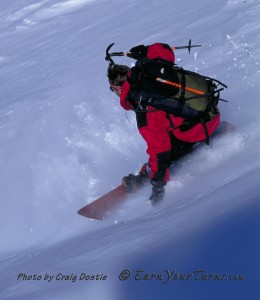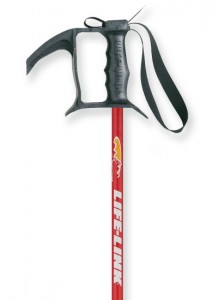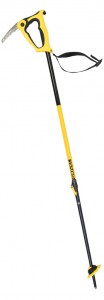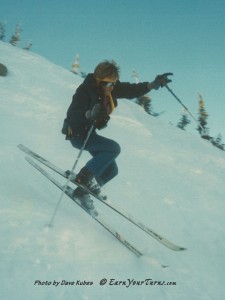Back in the day, when my goal was to set ever higher personal records for the length, width, and pitch of various couloirs a self arrest grip was standard equipment on all my ski tours. There were even a few times I carried them in-bounds.

Eric Blehm descends the headwall off Mt. Jepson (San Gorgonio Wilderness) with the short lived Leki SA grip.
They actually came in handy a few times at Mammoth when I fell in the Avy Chutes off Chair 22, or on Huevos off the top. Mostly they were used as an ascent tool when climbing uncharted couloirs of styrosnow in the backcountry.
My first pair were Ramer self arrest grips. Lots of people scoffed that being plastic they wouldn’t hold on real ice and I concur. Their real value wasn’t their ability to stop a slide on real ice, but as a litmus indicator while climbing. If they couldn’t punch through and help you with the climb, then perhaps the snow was no longer truly skiable and it was time to either turn around or find another descent line. Within that context, Ramer self arrest grips worked beautifully but they would not punch through and hold on dense, glazed ice. For that you needed a real ice axe made of steel. They did, however, arrest a number of blunders on steep, skiable snow.
At the time they were also the most comfortable ski grip on the market because the flat top was great for palming while skinning. The modern rounded tops on backcountry pole grips, carbon fiber shafts, and Flick-Lock™ adjustments had yet to be invented. The hooks were also good for snagging things you had dropped from your pack without having to bend over.
Paul Ramer has left us and his products are no longer available, but the classic Ramer self-arrest grip is still available on Life-Link ski poles. If you don’t attempt to ski steep black ice, this is all the arrest grip you should ever need.
In the 90s Andrew McLegend of Wasatch Chuting Gallery fame realized he needed a self arrest grip made of metal. Not an ice axe lashed to a ski pole – but an ice axe with a shorter pick integrated into a ski pole. As a designer for Black Diamond he made it his job to develop the Whippet. About all that has changed since the original design is that the blade is no longer removable for times when you don’t really need it. Impaling yourself remains a possibility, but most folks who deem it a necessary evil for safety when skiing le extrem are also capable of not skewering themselves accidentally in less critical zones, or if they do, they don’t blame BD for their carelessness with a loaded weapon. I’ve only needed the Whippet once, but once was enough for it to prove its value. I do advise looping your wrist through the ski straps before descending no-fall zone chutes. Even if you forget like I did but hold on like your life depends on it, they will still arrest a slide unless you’re just plain unlucky.
Grivel’s Condor
There is one other self-arrest grip made, but availability is suspect. Grivel took the basic Ramer design of an enclosed grip but made the arrest pick metal and retractable. It is simple, effective, and like the Whippet, if misused, potentially lethal. Of course, that’s what makes it a safety device. 😉 On a recent ascent of Mt. Shasta the question arose on whether to bring an ice axe or not. By strict mountaineering standards it was a necessary tool. Based on experience though I felt I could short cut the rules and get by with a self arrest grip, especially one with a retractable metal pick like the Grivel had. My only concern wasn’t with the pick part of the grip, but the twist lock style adjustable pole it was mounted to. It was the old style twist lock reminiscent of old school Leki poles that were notorious for untwisting. New poles come with a flick-lock style clamp. Fortunately the twist-lock held, and I only used the pick to hold on to the steep slope when taking an occasional pause on the ascent below the Red Banks. Like the Ramer grip, the Grivel handle palms well, but the strap location at the base of the grip did not make adjusting my hand position easy except by loosening it to the point it barely provided any level of retention security. I’m sure it would have held if I needed it to arrest a slide, but fortunately that real life test was not required. Half way down the West Face I folded the blade into the sheeth in the handle and the threat of self impalement disappeared. Would I recommend it? Absolutely. Can you find it stateside? Hardly.
Summary
Weight wise none of these poles will win any awards. If you think you need a self arrest grip for the descent you have planned, you probably do. If you’re sticking to skiable snow that you can hold a good edge on with your skis the Life-Link Ramer grip is good enough and not quite as lethal in an accidental fall as the metal options. If you’re not sure of the conditions and want full metal security, the Whippet is your go to tool and you won’t be disappointed unless you trip at the wrong moment on a mellow slope and skewer yourself. In the event of using it as intended, to arrest a fall on a steep, hard, even icy slope, the Whippet rules. Just be careful how you use that thing in less dangerous terrain since it’s always loaded. The Grivel is every bit as “safe” as the Whippet, but much harder to obtain.
What’s your take? Do you use self arrest grips always, sometimes or never?
© 2012





8 comments
Skip to comment form
I have used the original Ramer poles and Self-arrest grips as long as I have skied. I use them in “steep skiable snow”, but generally, like the overwhelming majority of BC skiers, I avoid “steep icy slopes.” The Ramers, if you have the original metal poles, actually whistle in the wind. I also like the adjustments “buttons” for length as much as the quick locks on the BD’s poles.
A pair of Whippets are quite a bit heavier than the Ramers. They are like carrying arm weights IMO, thus lack any “swing” motion for general downhill skiing. But they are bomb-proof which a positive. Grivels are nice with a retractable picket and are also lighter but they seem a bit cheap.
I cannot think of many instances where two self arrest grips would have improved my self-arrest response so I only carry one. If I am unsure on conditions I can use my regular poles and then carry a single self arrest pole, shortened and secured on my pack.
I paid dearly for a pair of Condors from Outdoor GB (shipped from Europe), but I really like them. I find that they replace a mountaineering axe in most situations. Having the blade fold up makes them much safer than other self arrest poles, and also keeps the snow off my knuckles when I’m daggering up steep snow. Having two poles makes it easier to balance when climbing or descending steep snow than a single axe would, allowing a more upright climbing stance. I have needed to use it to self arrest before in warm spring corn and was grateful to have one in each hand, since the blades are a bit smaller than a traditional axe so I needed the extra dig from two blades in order to stop myself. The whippet’s bent horizontal blade gives them a better grip in soft stuff.
My absolute favorite feature of the condor is the ability to use it cane style. It makes it much easier and stable on my knees when descending. Also on flats I find holding the top horizontal handle (pole backwards) makes a really nice pole swing balance and rhythm while I’m hiking. The space to wrap your fingers around the top handle is small, so it fits my small hands well, but might not fit most larger hands.
Grivel makes really high quality ergonomic stuff – the grip is comfortable and sturdy, and the blade is a work of art – but some of the mechanical designs are a little flimsy. The flicklock system is much better than a twist lock, though the poles taper alot so you can’t lock the pole in a short or collapsed position. I had trouble with the tightness of the screws that dial the flicklock tightness and I also had one fall out, so I replaced them with longer socket head cap screws, which work much better. The wrist straps are worthless since they come from below, so to save weight. The swiveling snow basket is a cool feature, though also not that durable. Finally, the screw that locks the blade open and closed is slow to use and rattles loose and get lost if you don’t pay attention. I need to figure out a better and more ergonomic screw knob.
So despite a few minor design gripes and having a ridiculously heavy weight for a trekking/ski pole, I still use these for everything from ice climb approaches, spring mountaineering, to trips where I actually bring skis. 🙂
Author
rideforthebrand – thanks for the long term durability perspective on the Condor. Hadn’t thought about the issue of the pick tightening screw, but that is an important point. Agree completely on the near worthlessness of the strap being connected at the bottom of the grip.
Salewa made a self arrest grip where you could screw in a pick of an ice axe. I could try to find it in my storage room and take a picture if you’d want one. Brought it a few times with me as a substitute for a real ice axe on glacier travel and sliding down snow patches in early summer. 🙂
You can buy just the Condor handles. They slip onto the top of a standard alu ski pole just like any other handle. (NB careful, they sit lower so you need to start with a longer pole)
I took the strap off (but I do that on all my ski poles, except for my whippets). The closed handle makes it less likely to lose the pole, a bit like those old Scott handles.
I never had an issue with the pick-lock screws. I did put a drop of light oil to them so they wouldn’t freeze up. When folding the pick in it may not go completlein due to ice. In this case the screw might be a bit loose once the ice is gone. I have gotton used to checking the crew is tight and, even though they are oiled, i have never lost one.
I’m planning a trip where a fall won’t be fun so got a Condor at considerable expense.
GearX and Telemark Pyrenees still had stock recently.
I’m not a fan of the 75mm basket that one retailer told me was the biggest. The Grivel website displays several sizes. BD baskets are supposed to fit but then you lose the swivel function.
The thing about these is technique.
You’ve got a split second before you hit warp speed, and you have to get the shaft under your chest hands either side and shoulder over the pick. That’s assuming you’re sliding feet first.
This takes a lot of practice.
How many do it?